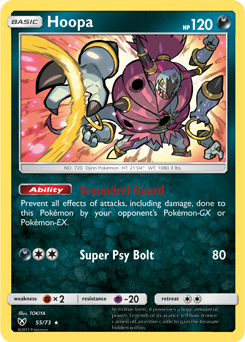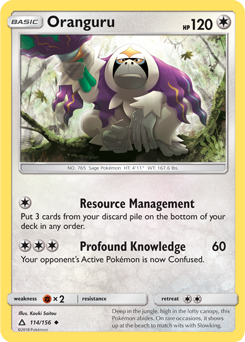Loop De Loop — A New Concept in Standard
Hey, PokeBeach readers. I am back with my newest article. Today, I am going to go over a new concept that I have been working on for the past month. In this article, I will go over my Zoroark-GX / Oranguru control deck that aims to play like Sableye / Garbodor in Expanded, go over some in depth strategies, and finally talk about its specific matchups. All of this information should be important because I am providing my personal lists and the results of my vigorous testing regimes. While I am unsure of the deck that I will be bringing with me to the 2018 Latin America International Championships in Sao Paulo, Brazil, this article should provide solid insight heading into that event. With all of that being said, let’s jump into my thought process of exploring ideas in our current Standard format.
Exploring Ideas in Standard
In the case of the current hyper-aggressive metagame, some decks are perfected fairly quickly and will remain that way until they are forced to adapt. In a recent phone call with my teammate Danny Altavilla, we discussed some new concepts as we head into Brazil:

- Attacking Alolan Ninetales
- Attacking Xurkitree-GX
- Attacking Hoopa
- Zoroark-GX / Garbodor / Oranguru
- Zoroark-GX / Counter Energy / Sudowoodo / Shaymin
- Zoroark-GX / Garbodor / Bursting Balloon
- Zoroark-GX / Glaceon-GX
- Glaceon-GX / Seviper
- Magnezone / Dialga-GX
- Tapu Bulu-GX / Vikavolt / Order Pad
- Regigigas Stall
The original ideas focused on evolving the Attacking Hoopa deck that Altavilla played to great success at the 2018 Portland, Oregon Regional Championships. However, we quickly realized that those concepts suffered from poor matchups or could easily be teched against. Through this conversation, we took the established Attacking Hoopa archetype and spiritually evolved it into Zoroark-GX / Oranguru Control. The idea stemmed from recreating Sableye / Garbodor from Expanded and making it playable in Standard. Looking past the obvious cards such as Sableye that don’t exist in Standard, we took similar cards, mashed them together, and created the following list:
Zoroark-GX / Oranguru Control Deck
Strategies Within the Deck
In this deck, there are many “concept within a concept” plays that give the deck a high skill gap. In most cases, the win condition is running your opponent out of Energy cards and attacking with Zoroark-GX while your opponent has no reasonable response. While it may seem impossible to achieve this feature, Oranguru can use its Resource Management attack to start an infinite loop.
Oranguru Loop
In the following scenario, the Zoroark-GX / Oranguru Control deck will be playing against an Attacking Hoopa deck:

- Player 1: Starts game with Hoopa, attaches a basic Darkness Energy to Hoopa, passes.
- Player 2: Starts Zorua, plays Tapu Lele-GX down from hand, uses Wonder Tag, and searches out a Brigette. Plays Brigette, searches for Zorua, Zorua, Oranguru and places them on the Bench. Attaches a basic Darkness Energy to Oranguru and passes.
- Player 1: Attaches a Double Colorless Energy to Hoopa and uses Super Psy Bolt to Knock Out the opposing Zorua for 80 damage.
- Player 2: Promotes Oranguru, evolves a Zorua into a Zoroark-GX, evolves a Zorua into a Zoroark-GX, and plays down an Oranguru down from their hand. They use Trade, discard a Brigette, play a Professor Sycamore, use Trade, discard an Ultra Ball, and use Resource Management to put a Zorua, Ultra Ball, and Professor Sycamore at the bottom of their deck.
- Player 1: Benches a Hoopa, attaches a basic Darkness Energy to Hoopa, and uses Super Psy Bolt on Oranguru for 80 damage.
- Player 2: Uses Trade, discards a Brigette, uses Trade, discards an N, plays an Ultra Ball, discards a Puzzle of Time and Double Colorless Energy from their hand, searches for a Zorua, plays a Zorua on the Bench, and plays an Acerola to bring the Oranguru back into their hand. They promote a Zoroark-GX, attach a Float Stone to Zoroark-GX, play Oranguru on their Bench, attach a basic Darkness Energy to Oranguru, and retreat Zoroark-GX into Oranguru. Oranguru uses Resource Management to put Puzzle of Time, N, and a Double Colorless Energy at the bottom of their deck.
- Player 1: Benches an Oranguru, attaches a Double Colorless Energy to Hoopa, and uses Super Psy Bolt on Oranguru for 80 damage.
- Player 2: Uses Trade, discards a Cynthia, uses Trade, discards a Crushing Hammer, plays an Ultra Ball, discards an Enhanced Hammer and basic Darkness Energy from their hand, searches for a Zoroark-GX, evolves Zorua into a Zoroark-GX, uses Trade, and discards a Field Blower. They use two Puzzle of Time, retrieve back a Field Blower and Acerola, and play an Acerola to bring the Oranguru back into their hand. They promote a Zoroark-GX with Float Stone, play Oranguru on their Bench, attach a basic Darkness Energy to Oranguru, and retreat Zoroark-GX into Oranguru. Oranguru uses Resource Management to put Puzzle of Time, Puzzle of Time, and a basic Darkness Energy at the bottom of their deck.
As you can tell, this loop requires you whittling your deck down to almost nothing and to use Resource Management to continuously cycle back in important cards. In this situation, it is impossible for Attacking Hoopa to win the game because they will eventually deck out unless they use their own Oranguru. If they do use their own Oranguru, you can promote a Zoroark-GX, attach a Double Colorless Energy and Knock Out their Oranguru. So they have two options: try to attack with Oranguru again if they can get it back, or to attack with Hoopa which you should not be able to Knock Out. In any case, you should always resort back to Acerola, retreat, and Resource Management unless you can Knock Out a Pokemon. This is a sound strategy versus any deck that can’t do more than 110 damage or against inexperienced players who don’t understand how this loop works. Furthermore, this list plays two copies of Fighting Fury Belt to bring that damage cap of 110 damage to 150 damage to be able to withstand larger blows. I have practiced this loop for over 20 hours and have found that it has a 100% success rate against attacking Hoopa and is similar in success when facing a Sylveon-GX / Gardevoir-GX deck.
This concludes the public portion of this article.
If you'd like to continue reading, consider purchasing a PokeBeach premium membership! If you're not completely satisfied with your membership, you can request a full refund within 30 days.
Each week we post high-quality content from some of the game's top players. Our article program isn't a corporate operation, advertising front, or for-profit business. We set our prices so that we can pay the game's top players to write the best content for our subscribers. Each article topic is carefully selected, goes through multiple drafts, and is touched up by our editors. We take great pride in our program!

